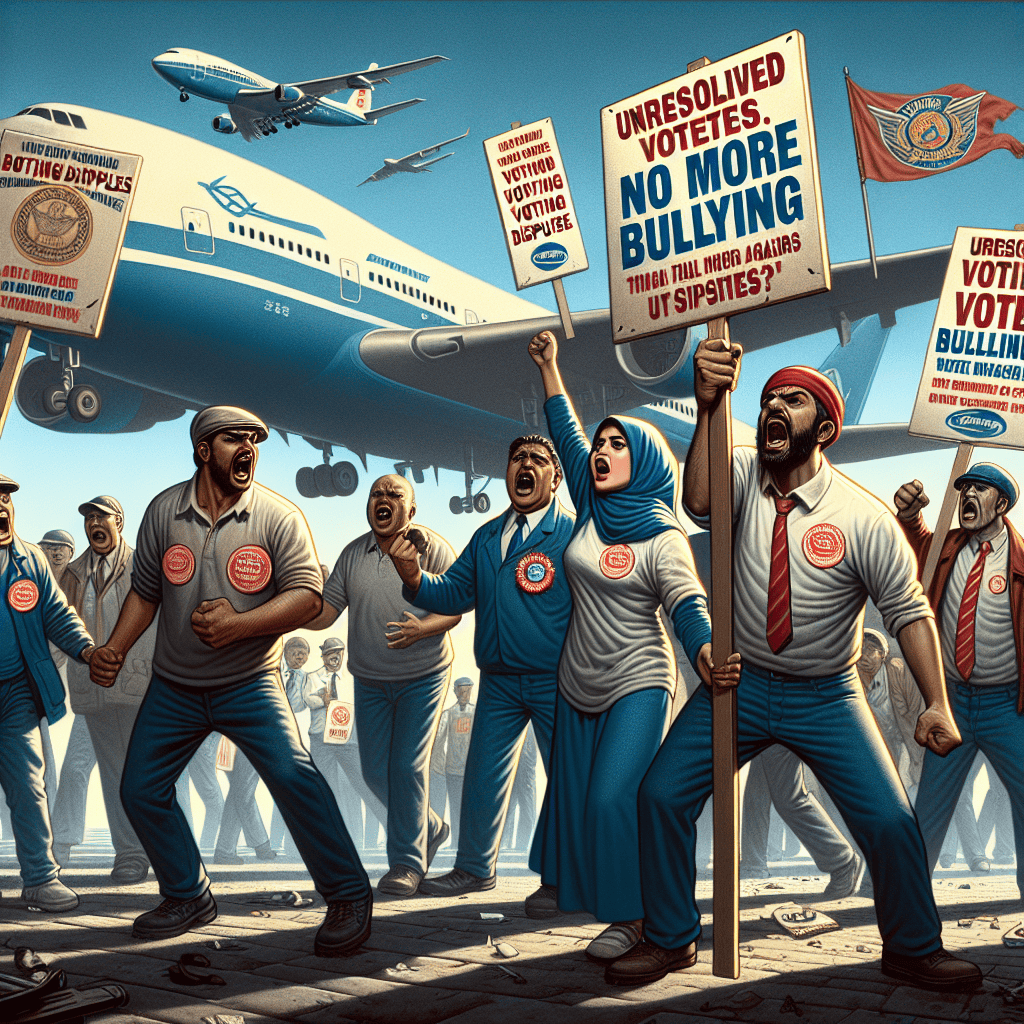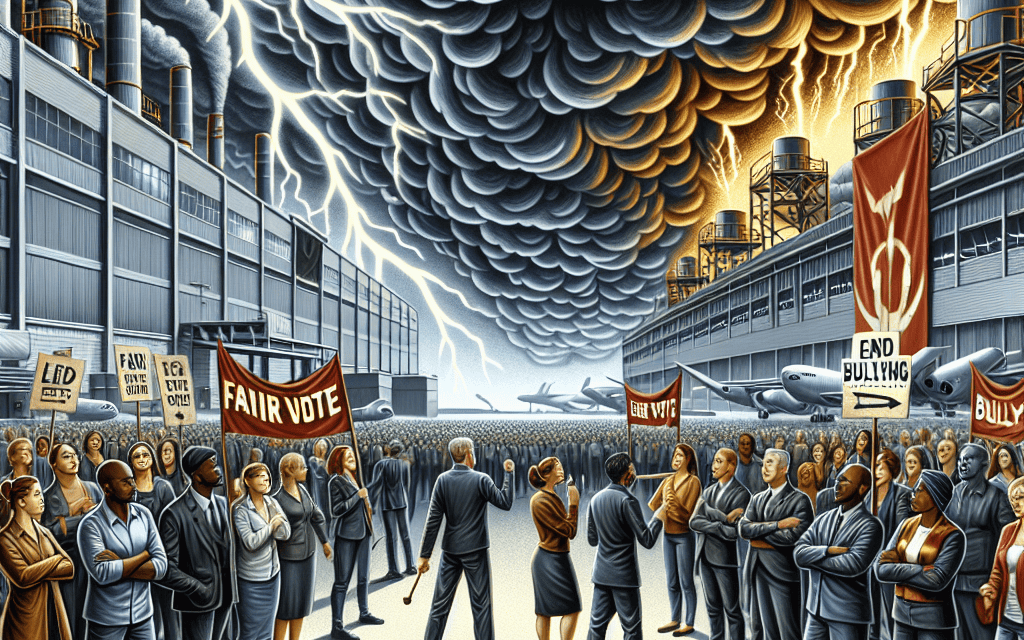“Unity in Strife: Boeing Union Stands Against Bullying Amidst Strike Vote Tensions”
Introduction
In a recent development, tensions have escalated among striking Boeing workers as union leaders publicly condemned instances of bullying and intimidation related to disputes over voting procedures. The union, representing a significant portion of Boeing’s workforce, has expressed deep concern over what it describes as “vile” behavior among its members, which has surfaced during ongoing strikes. These strikes, primarily focused on labor conditions and contract negotiations, have been further complicated by internal disagreements over voting processes and outcomes. The union’s leadership has called for unity and respect among workers, emphasizing the importance of maintaining solidarity in their collective bargaining efforts while addressing the disruptive conduct that threatens to undermine their cause.
Impact Of Bullying On Union Solidarity During Strikes
The recent condemnation by the Boeing union of what it describes as “vile” bullying among striking workers over vote disputes highlights a significant issue that can undermine the very foundation of union solidarity during strikes. Strikes are a powerful tool for workers to express their collective grievances and demand better working conditions, wages, and benefits. However, the effectiveness of a strike largely depends on the unity and solidarity of the workers involved. When internal conflicts arise, particularly in the form of bullying, the cohesion necessary for a successful strike can be severely compromised.
Bullying within the ranks of striking workers can manifest in various forms, including verbal harassment, intimidation, and social ostracism. These behaviors can create a toxic environment that not only affects the morale of individual workers but also weakens the collective resolve of the group. When workers are divided by internal disputes, their ability to present a united front to management is diminished. This division can lead to a breakdown in negotiations, as employers may exploit these rifts to undermine the workers’ demands.
Moreover, the presence of bullying can deter participation in union activities, as workers may fear becoming targets themselves. This fear can lead to decreased involvement in strike actions, reducing the overall impact of the strike. In some cases, workers may even cross picket lines or return to work prematurely, further eroding the strike’s effectiveness. The resulting lack of participation can embolden employers to resist meeting the union’s demands, knowing that the workers are not fully united.
The impact of bullying on union solidarity is not limited to the immediate context of a strike. It can have long-lasting effects on the union’s ability to organize and advocate for its members. Trust and camaraderie, essential components of any successful union, can be severely damaged by bullying. Workers who have experienced or witnessed bullying may become disillusioned with the union, leading to decreased membership and participation in future actions. This erosion of trust can make it more challenging for the union to mobilize its members and effectively negotiate on their behalf.
Addressing bullying within the union is crucial to maintaining solidarity and ensuring the success of strike actions. Union leaders must take a proactive approach to foster an inclusive and respectful environment among their members. This can be achieved through clear communication of anti-bullying policies, providing support and resources for those affected, and promoting a culture of mutual respect and understanding. By addressing these issues head-on, unions can strengthen their solidarity and enhance their ability to advocate for workers’ rights.
In conclusion, the condemnation of bullying among striking workers by the Boeing union serves as a stark reminder of the detrimental impact such behavior can have on union solidarity. Strikes rely on the collective strength and unity of workers, and internal conflicts can significantly undermine these efforts. By addressing bullying and fostering a supportive environment, unions can maintain their solidarity and effectively advocate for their members’ interests. As the labor movement continues to face challenges in an ever-evolving economic landscape, the importance of unity and mutual respect among workers cannot be overstated.
Strategies For Conflict Resolution Among Striking Workers
In the complex landscape of labor strikes, maintaining unity among workers is crucial for achieving collective goals. However, disputes can arise, particularly when opinions differ on voting matters related to strike actions. Recently, the Boeing union has condemned what it describes as “vile” bullying among striking workers, highlighting the need for effective conflict resolution strategies. Understanding and implementing these strategies can help mitigate tensions and foster a more cohesive environment during such critical times.
To begin with, open communication is fundamental in resolving conflicts among striking workers. Encouraging dialogue allows individuals to express their concerns and grievances, which can prevent misunderstandings from escalating into more significant disputes. Establishing regular meetings where workers can voice their opinions and discuss voting matters can create a platform for transparency and inclusivity. This approach not only helps in addressing immediate issues but also builds trust among workers, reinforcing the collective strength of the union.
Moreover, mediation can serve as an effective tool in conflict resolution. Involving a neutral third party to facilitate discussions can help de-escalate tensions and guide workers towards a mutually agreeable solution. Mediators can provide an unbiased perspective, helping to identify common ground and encouraging compromise. This process can be particularly beneficial when emotions run high, as it allows for a structured environment where all parties feel heard and respected.
In addition to mediation, fostering a culture of respect and empathy is essential. Workers should be encouraged to consider the perspectives of their colleagues, recognizing that differing opinions are a natural part of any democratic process. By promoting empathy, unions can help reduce instances of bullying and create a more supportive atmosphere. Training sessions on conflict resolution and communication skills can equip workers with the tools they need to navigate disagreements constructively.
Furthermore, establishing clear guidelines and protocols for handling disputes can provide a framework for addressing conflicts efficiently. These guidelines should outline acceptable behavior and the steps to be taken when conflicts arise, ensuring that all workers are aware of the procedures in place. By having a structured approach, unions can prevent conflicts from spiraling out of control and maintain focus on the overarching goals of the strike.
It is also important to recognize the role of leadership in conflict resolution. Union leaders must set the tone for how disputes are managed, demonstrating a commitment to fairness and inclusivity. By leading by example, they can inspire workers to adopt a similar approach, fostering a culture of collaboration and mutual respect. Leaders should also be proactive in identifying potential sources of conflict and addressing them before they escalate, ensuring that the union remains united in its efforts.
Finally, reflecting on past conflicts and learning from them can provide valuable insights for future strikes. By analyzing what strategies were effective and which areas need improvement, unions can continuously refine their approach to conflict resolution. This ongoing process of evaluation and adaptation can strengthen the union’s ability to handle disputes, ultimately contributing to more successful strike actions.
In conclusion, while conflicts among striking workers are inevitable, they do not have to undermine the collective efforts of a union. By prioritizing open communication, mediation, empathy, clear guidelines, strong leadership, and continuous learning, unions can effectively manage disputes and maintain unity. These strategies not only address immediate conflicts but also contribute to a more resilient and cohesive workforce, better equipped to achieve their shared objectives.
The Role Of Leadership In Managing Disputes During Strikes
In the complex landscape of labor strikes, the role of leadership is pivotal in managing disputes and maintaining unity among workers. This becomes particularly evident in situations where internal conflicts arise, such as the recent incident involving Boeing union members. The union has condemned what it describes as “vile” bullying among striking workers, highlighting the challenges leaders face in navigating disagreements over vote outcomes. Such disputes can undermine the collective strength of a strike, making effective leadership essential to ensure that the primary objectives of the labor action are not overshadowed by internal discord.
Leadership in a union context involves not only advocating for workers’ rights but also fostering an environment of respect and solidarity. When disputes over voting outcomes occur, as seen in the Boeing strike, it is crucial for leaders to address these issues promptly and decisively. This involves setting clear guidelines for conduct and communication among members, emphasizing the importance of unity in achieving common goals. By doing so, leaders can help mitigate the negative impact of internal conflicts and maintain focus on the broader objectives of the strike.
Moreover, effective leadership requires transparency and open communication. In the case of the Boeing union, addressing allegations of bullying necessitates a thorough investigation and a commitment to transparency in the process. Leaders must ensure that all members feel heard and respected, regardless of their stance on the vote. This can be achieved through regular meetings, open forums for discussion, and clear communication channels that allow members to express their concerns without fear of retribution. By fostering an inclusive environment, leaders can help bridge divides and reinforce the collective strength of the union.
In addition to addressing internal conflicts, leaders must also navigate external pressures that can exacerbate tensions among striking workers. The public and media scrutiny that often accompanies high-profile strikes can amplify internal disputes, making it even more important for leaders to maintain a united front. This involves not only managing the narrative presented to the public but also ensuring that all members are aligned in their messaging and objectives. By presenting a cohesive and unified stance, leaders can strengthen the union’s position and increase the likelihood of achieving favorable outcomes.
Furthermore, leadership during a strike involves strategic decision-making and negotiation skills. Leaders must balance the immediate needs of their members with long-term goals, often requiring difficult decisions and compromises. In the context of the Boeing strike, this may involve negotiating with management to address the concerns that led to the strike while also ensuring that the internal disputes do not derail the overall objectives. Effective leaders must be adept at navigating these complexities, using their skills to guide the union through challenging times.
Ultimately, the role of leadership in managing disputes during strikes is multifaceted and requires a delicate balance of advocacy, communication, and strategic thinking. The situation with the Boeing union serves as a reminder of the challenges leaders face in maintaining unity and focus amid internal and external pressures. By prioritizing transparency, inclusivity, and strategic decision-making, leaders can help ensure that the collective strength of the union is preserved, allowing them to effectively advocate for the rights and interests of their members.
Historical Context Of Union Strikes And Internal Conflicts

The history of union strikes is deeply intertwined with the broader narrative of labor rights and industrial relations. Strikes have long served as a powerful tool for workers to negotiate better terms of employment, including fair wages, safer working conditions, and reasonable hours. However, the path to achieving these goals has often been fraught with internal conflicts and disputes, as evidenced by the recent condemnation by a Boeing union of what it described as “vile” bullying among striking workers over vote disputes. This incident highlights a recurring theme in the history of labor movements: the tension between solidarity and internal discord.
Throughout the 19th and 20th centuries, labor strikes were pivotal in shaping the modern workplace. The industrial revolution brought about significant changes in production methods, leading to the rise of factories and a new class of industrial workers. As these workers sought to improve their often harsh working conditions, they organized into unions and resorted to strikes as a means of exerting pressure on employers. While these strikes were instrumental in securing many of the labor rights enjoyed today, they were not without their challenges. Internal conflicts frequently arose, often centered around differing opinions on strike strategies, leadership decisions, and the handling of negotiations.
The recent situation at Boeing is a contemporary reflection of these historical dynamics. As workers engage in strikes to advocate for their rights, disagreements can emerge regarding the best course of action. In the case of Boeing, the union’s condemnation of bullying among its members underscores the difficulties in maintaining unity during such critical times. This internal strife can be attributed to various factors, including differing perspectives on the effectiveness of strike tactics, the interpretation of union leadership’s decisions, and the personal stakes involved for each worker.
Moreover, the issue of vote disputes is not new in the context of union strikes. Voting on whether to accept or reject a proposed contract is a crucial aspect of the collective bargaining process. It is a moment when individual opinions converge to form a collective decision that will impact all members. However, this process can also be a source of contention, as differing views on what constitutes an acceptable agreement can lead to heated debates and, at times, personal attacks. The Boeing union’s response to the bullying incident reflects an awareness of the need to address such conflicts to preserve the integrity and effectiveness of the strike.
In examining the historical context of union strikes and internal conflicts, it becomes evident that while solidarity is a fundamental principle of labor movements, it is not always easily achieved. The challenges faced by striking workers at Boeing are emblematic of the broader struggles within labor unions to balance diverse opinions and maintain cohesion. As unions continue to play a vital role in advocating for workers’ rights, addressing internal conflicts and fostering a culture of respect and collaboration remain essential.
In conclusion, the Boeing union’s condemnation of bullying among striking workers serves as a reminder of the complexities inherent in labor strikes. While the primary focus is often on the external battle between workers and employers, the internal dynamics within unions are equally significant. By understanding and addressing these internal conflicts, unions can strengthen their collective efforts and continue to be a formidable force in the pursuit of labor justice.
Legal Implications Of Bullying Within Unionized Workforces
The issue of bullying within unionized workforces, particularly during periods of industrial action, presents complex legal implications that demand careful consideration. Recently, the Boeing union has condemned what it describes as “vile” bullying among striking workers, highlighting the tensions that can arise over vote disputes. This situation underscores the need for a nuanced understanding of the legal frameworks governing union activities and the rights of individual workers.
In unionized environments, the collective bargaining process is a cornerstone of labor relations, providing workers with a unified voice to negotiate terms and conditions of employment. However, when disagreements arise within the union, particularly during strikes, the potential for internal conflict increases. The Boeing union’s recent condemnation of bullying behavior among its members illustrates the challenges that can emerge when individual opinions clash with collective decisions. Such disputes often center around voting on strike actions or contract agreements, where differing perspectives can lead to friction and, in some cases, intimidation.
From a legal standpoint, bullying within a unionized workforce can have significant implications. Labor laws are designed to protect workers’ rights to organize and engage in collective bargaining, but they also safeguard individual employees from harassment and coercion. When bullying occurs, it may violate these protections, potentially leading to legal action against the union or the individuals involved. Moreover, unions have a duty to ensure a safe and respectful environment for all members, which includes addressing any instances of bullying promptly and effectively.
The legal ramifications of bullying in this context are multifaceted. On one hand, unions must navigate the delicate balance between maintaining solidarity and respecting individual autonomy. On the other hand, they must also comply with legal obligations to prevent and address harassment. Failure to do so can result in legal challenges, including claims of unfair labor practices or breaches of duty of fair representation. These legal issues can be further complicated by the fact that union activities are often protected under labor laws, which can make it difficult to hold unions accountable for the actions of individual members.
In addition to legal consequences, bullying within unionized workforces can have broader implications for labor relations. It can undermine trust and cohesion among workers, weakening the union’s ability to effectively advocate for its members. Furthermore, it can damage the union’s reputation, both internally and externally, potentially affecting its bargaining power and public perception. As such, addressing bullying is not only a legal imperative but also a strategic necessity for unions seeking to maintain their influence and effectiveness.
To mitigate the risk of bullying and its associated legal implications, unions must implement robust policies and procedures for handling disputes and grievances. This includes providing clear guidelines on acceptable behavior, establishing mechanisms for reporting and investigating complaints, and offering support and resources for affected members. By fostering a culture of respect and inclusivity, unions can help prevent bullying and ensure that all members feel valued and heard.
In conclusion, the condemnation of bullying among striking Boeing workers highlights the complex legal and relational challenges faced by unionized workforces. As unions navigate these issues, they must balance the need for collective action with the rights and well-being of individual members. By addressing bullying proactively and comprehensively, unions can uphold their legal obligations, strengthen their internal cohesion, and enhance their overall effectiveness in representing workers’ interests.
Psychological Effects Of Workplace Bullying On Striking Workers
The recent condemnation by the Boeing union of the “vile” bullying among striking workers over vote disputes has brought to light the psychological effects of workplace bullying, particularly in the context of labor strikes. Striking workers, already under significant stress due to financial uncertainties and job security concerns, face additional psychological burdens when subjected to bullying by their peers. This phenomenon not only affects the individuals involved but also has broader implications for the cohesion and effectiveness of the strike itself.
Workplace bullying, characterized by repeated and persistent negative actions intended to intimidate or harm, can have severe psychological effects on individuals. For striking workers, the stress of being on the picket line is compounded by the fear of being ostracized or targeted by fellow workers. This can lead to increased anxiety, depression, and a sense of isolation. The emotional toll of such experiences can be profound, affecting not only the mental health of the individuals involved but also their physical well-being. Chronic stress and anxiety can lead to a host of health issues, including insomnia, headaches, and a weakened immune system.
Moreover, the psychological effects of bullying can undermine the solidarity that is crucial for the success of a strike. When workers are divided by internal conflicts, the collective bargaining power of the union is weakened. This division can be particularly damaging when it stems from disputes over voting on strike-related decisions. Such disputes can create an environment of mistrust and resentment, further exacerbating the stress experienced by workers. The resulting fragmentation can lead to a breakdown in communication and cooperation, making it more challenging to achieve the goals of the strike.
In addition to the immediate psychological effects, the long-term consequences of workplace bullying during a strike can be significant. Workers who experience bullying may carry the emotional scars long after the strike has ended, affecting their future interactions with colleagues and their overall job satisfaction. This can lead to increased turnover and a loss of experienced workers, which can be detrimental to both the union and the employer.
Addressing the issue of bullying among striking workers requires a multifaceted approach. Unions must take a proactive stance in promoting a culture of respect and inclusivity, ensuring that all workers feel valued and supported. This can be achieved through education and training programs that raise awareness about the impact of bullying and provide strategies for conflict resolution. Additionally, unions should establish clear policies and procedures for reporting and addressing incidents of bullying, ensuring that workers feel safe and supported in coming forward with their concerns.
Furthermore, fostering open communication and dialogue among workers can help to mitigate the effects of bullying and promote a sense of unity. Encouraging workers to express their views and concerns in a respectful and constructive manner can help to prevent misunderstandings and reduce tensions. By creating an environment where workers feel heard and respected, unions can strengthen their collective bargaining power and improve the overall effectiveness of the strike.
In conclusion, the psychological effects of workplace bullying on striking workers are significant and multifaceted. Addressing this issue is essential not only for the well-being of the individuals involved but also for the success of the strike as a whole. By promoting a culture of respect and inclusivity, and by providing support and resources for workers, unions can help to mitigate the negative effects of bullying and foster a more cohesive and effective labor movement.
Effective Communication Techniques To Address Vote Disputes In Unions
In the complex landscape of labor unions, effective communication is paramount, especially when addressing sensitive issues such as vote disputes. Recently, the Boeing union has been thrust into the spotlight due to allegations of ‘vile’ bullying among striking workers, highlighting the urgent need for robust communication strategies. As unions navigate these turbulent waters, it becomes essential to employ techniques that not only address the immediate concerns but also foster a culture of respect and understanding.
To begin with, establishing a clear and open line of communication is crucial. Union leaders must ensure that all members are informed about the voting process, the issues at stake, and the implications of their decisions. This can be achieved through regular meetings, newsletters, and digital platforms that provide updates and facilitate dialogue. By keeping members informed, misunderstandings and misinformation can be significantly reduced, thereby minimizing the potential for conflict.
Moreover, active listening plays a vital role in resolving disputes. Union leaders should create forums where members feel heard and valued. This involves not only listening to their concerns but also acknowledging their emotions and perspectives. By doing so, leaders can build trust and demonstrate empathy, which are essential components in de-escalating tensions. Furthermore, active listening can uncover underlying issues that may not be immediately apparent, allowing for more comprehensive solutions.
In addition to active listening, mediation can serve as an effective tool in addressing vote disputes. Neutral mediators can facilitate discussions between conflicting parties, helping them to articulate their positions and work towards a mutually acceptable resolution. Mediation encourages collaboration and compromise, which are often necessary in finding common ground. By involving a neutral third party, unions can ensure that the process remains fair and unbiased, thereby enhancing the credibility of the outcome.
Another important technique is the use of clear and concise language. Miscommunication often arises from ambiguous or overly complex language, which can lead to misunderstandings and further exacerbate tensions. Union leaders should strive to communicate in a straightforward manner, avoiding jargon and ensuring that all members, regardless of their background, can understand the information being presented. This clarity can prevent unnecessary disputes and foster a more inclusive environment.
Furthermore, it is essential to address bullying and harassment swiftly and decisively. The Boeing union’s recent condemnation of ‘vile’ bullying underscores the importance of maintaining a respectful and safe environment for all members. Union leaders must establish and enforce a zero-tolerance policy towards such behavior, ensuring that any incidents are investigated thoroughly and appropriate actions are taken. By doing so, unions can protect their members and uphold the integrity of the organization.
Finally, fostering a culture of inclusivity and respect is fundamental in preventing vote disputes from escalating into more serious conflicts. This involves promoting diversity and ensuring that all voices are heard and valued. By embracing different perspectives and encouraging open dialogue, unions can create a more harmonious and cooperative environment.
In conclusion, effective communication is the cornerstone of addressing vote disputes within unions. By employing techniques such as open communication, active listening, mediation, clear language, and a commitment to inclusivity, union leaders can navigate these challenges with greater ease. As the Boeing union’s recent experiences illustrate, the stakes are high, but with the right strategies, unions can overcome these obstacles and emerge stronger and more united.
Q&A
1. **What is the main issue reported in the article?**
The article reports on bullying and harassment among striking Boeing workers, particularly related to disputes over voting on union matters.
2. **Who is condemning the bullying behavior?**
The union representing the Boeing workers is condemning the bullying behavior.
3. **What specific actions are being condemned?**
The union condemns actions such as intimidation, harassment, and other forms of bullying among workers.
4. **What is the context of the strike?**
The strike is related to labor disputes, likely involving contract negotiations or working conditions at Boeing.
5. **How has the union responded to the bullying allegations?**
The union has publicly condemned the behavior and is likely taking steps to address and resolve the issue among its members.
6. **What impact does the bullying have on the strike?**
Bullying can create divisions among workers, undermine solidarity, and potentially weaken the effectiveness of the strike.
7. **What are the potential consequences for workers involved in bullying?**
Workers involved in bullying could face disciplinary actions from the union or legal consequences, depending on the severity of their actions.
Conclusion
The Boeing union’s condemnation of “vile” bullying among striking workers over vote disputes highlights significant internal tensions and challenges within the labor movement. Such behavior undermines the solidarity and collective bargaining power essential for effective labor negotiations. Addressing these issues is crucial for maintaining unity and ensuring that the workers’ voices are represented fairly and respectfully. The union must take decisive action to foster a more inclusive and respectful environment, emphasizing the importance of democratic processes and mutual respect among its members to achieve their common goals.





